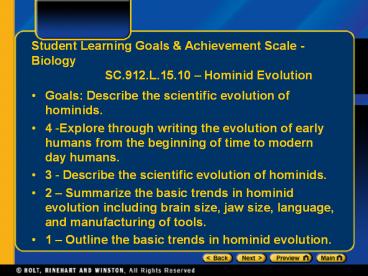Student Learning Goals - PowerPoint PPT Presentation
1 / 13
Title:
Student Learning Goals
Description:
Title: No Slide Title Author: Kelly L. Moore Last modified by: Kelly L. Moore Document presentation format: On-screen Show (4:3) Other titles: Arial Times Default ... – PowerPoint PPT presentation
Number of Views:68
Avg rating:3.0/5.0
Title: Student Learning Goals
1
Student Learning Goals Achievement Scale -
Biology SC.912.L.15.10 Hominid Evolution
- Goals Describe the scientific evolution of
hominids. - 4 -Explore through writing the evolution of early
humans from the beginning of time to modern day
humans. - 3 - Describe the scientific evolution of
hominids. - 2 Summarize the basic trends in hominid
evolution including brain size, jaw size,
language, and manufacturing of tools. - 1 Outline the basic trends in hominid
evolution.
2
Objectives
Section 4 Primates and Human Origins
Chapter 43
- Identify traits that distinguish primates from
other mammals. - Describe fossil evidence relating humans to
primate ancestors. - Compare hypotheses concerning hominid evolution.
3
Primate Characteristics
Section 4 Primates and Human Origins
Chapter 43
- Many primate characteristics are generalized
rather than specialized and are similar to
features possessed by ancestral mammals. - Many primate traits are adaptations for living in
groups in trees. - Examples include strong three-dimensional vision
and prehensile appendages, or hands, feet, and
tails that can grasp. - The primate brain, with its large cerebrum, is
able to interpret complex visual information and
keep track of subtle shifts in social
organization.
4
Primate Characteristics, continued
Section 4 Primates and Human Origins
Chapter 43
- Primate characteristics include
- Large brain parts relative to size
- Acute color vision
- Generalist teeth
- Communication
- Infant care
- Manual dexterity
- Social organization
- Characteristic skeletal structure
5
Primate Characteristics, continued
Section 4 Primates and Human Origins
Chapter 43
- Anthropoids
- The primate lineages that evolved the earliest
include lemurs, lorises, and tarsierssometimes
referred to as prosimians. - The anthropoid primates include gibbons, New
World monkeys, Old World monkeys, and apes,
including humans. - Anthropoid adaptations include rotating shoulder
and elbow joints and an opposable thumb. - All anthropoids have a similar dental formula.
- Compared to other primates, anthropoids have a
more complex brain structure and a larger brain
relative to body size. - Orangutans, gorillas, chimpanzees, bonobos, and
humans make up the great apes.
6
Primate Characteristics, continued
Section 4 Primates and Human Origins
Chapter 43
- Modern Humans
- Among living mammals, only humans, Homo sapiens,
have the trait of bipedalism. - The human skeleton is adapted for bipedalism in
several ways. - The bowl-shaped human pelvis supports internal
organs. - The human spine curves in an S shape.
- Human toes are aligned with each other and are
short. - The larger brain and smaller jaw in humans result
in a flatter face than that found in apes. - The human brain is capable of speech
communication.
7
Primate Characteristics, continued
Section 4 Primates and Human Origins
Chapter 43
- Hominids
- Hominids include humans and extinct humanlike
anthropoid species. - Bipedalism is the distinguishing characteristic
of this group. - Apelike ancestors of the first hominids were
probably quadrupedal. - Fossil evidence has provided some clues as to how
long ago the first bipedal hominid evolved.
8
Fossil Hominids
Section 4 Primates and Human Origins
Chapter 43
- Paleontologists and anthropologists have
concluded that a variety of humanlike species
lived on Earth within the past 10 million years. - Australopithecines
- A number of fossils of bipedal anthropoid
primates with the brain size of a chimpanzee have
been discovered in parts of Africa and date from
about 2.5 million to 4 million years ago. - These organisms have been classified in the genus
Australopithecus within the subfamily of
australopithecines, which may include other
genera. - The first australopithecine fossil discovery,
nicknamed Lucy, was found in 1974 in the Afar
Valley region of Africa by Donald Johanson and
colleagues.
9
Comparison of Gorilla and Australopithecine
Skeletons
Section 4 Primates and Human Origins
Chapter 43
10
Many Hominid Species
Section 4 Primates and Human Origins
Chapter 43
- Paleontologists continue to find new hominid
fossils and debate their classification. - It is clear that several hominid forms arose,
thrived, and became extinct over the past 7
million years. Different species may have
coexisted in time and possibly interacted. - Early hominid species include
- Gracile (slender) australopithecines
- Australopithecus afarensis (Lucys species)
- A. anamensis
- A. africanus
- Robust australopithecines (may be genus
Paranthropus) - A. aethiopicus
- A. robustus
- A. boisei
11
Humans
Section 4 Primates and Human Origins
Chapter 43
- Sometime after australopithecines, the genus Homo
appeared. - Extinct and living members of this genus are
called humans. - Homo habilis and Homo erectus
- Homo habilis means the handy human.
- A later species was Homo erectus (meaning
upright human). - Homo sapiens and Homo neanderthalensis
- Neanderthals, now classified as H.
neanderthalensis, lived in Europe and Asia from
about 230,000 to 30,000 years ago. - They may have interacted with H. sapiens in some
places. - The first humans classified as H. sapiens
appeared about 160,000 years ago. - Some early fossils of H. sapiens are referred to
as Cro-Magnons.
12
Humans, continued
Section 4 Primates and Human Origins
Chapter 43
- Modern Humans
- Two major hypotheses have been proposed to
explain how modern humans come to occupy the
entire globe - In the multiregional hypothesis, local
populations of H. erectus gave rise to local
populations of H. sapiens all over the world. - In the recent-African-origin hypothesis, H.
sapiens evolved from H. erectus in Africa, then
migrated out of Africa and populated the globe. - An analysis of mitochondrial DNA from people
around the world suggests that humans did arise
in Africa.
13
Hominids in the Fossil Record
Section 4 Primates and Human Origins
Chapter 43































